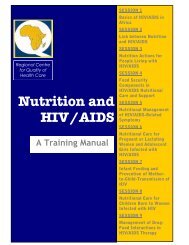2.1: Anthropometric Indicators Measurement Guide - Linkages Project
2.1: Anthropometric Indicators Measurement Guide - Linkages Project
2.1: Anthropometric Indicators Measurement Guide - Linkages Project
You also want an ePaper? Increase the reach of your titles
YUMPU automatically turns print PDFs into web optimized ePapers that Google loves.
Change in weight-for-height (wasting) is a<br />
good example of an indicator of shortterm<br />
response in a wasted child being<br />
treated for malnutrition, whereas a<br />
decrease in the prevalence of stunting at<br />
the population level is a long-term<br />
indicator that social development is<br />
benefiting the poor as well as the<br />
comparatively affluent. On the other<br />
hand, a decrease in the prevalence of low<br />
birth weight might be used to indicate<br />
success in such activities as controlling<br />
malaria during pregnancy.<br />
In describing an indicator of response,<br />
the possible lag between the start of an<br />
intervention and the time when a<br />
response becomes apparent is an<br />
important consideration. At the individual<br />
level, a wasted infant will respond to<br />
improved nutrition first by putting on<br />
weight and then by “catching up” in linear<br />
growth. At the population level, however,<br />
decades may elapse before improvements<br />
can be seen in adult height.<br />
Excluding individuals from high-risk<br />
treatments, from employment or from<br />
certain benefits. Decisions regarding an<br />
individual’s inclusion in, or exclusion<br />
from, a high-risk treatment protocol,<br />
consideration for employment in a<br />
particular setting (e.g. an occupation<br />
requiring appreciable physical strength),<br />
or admission to certain benefits (e.g. low<br />
life-insurance rates) depend on indicators<br />
that predict a lack of risk.<br />
<strong>Anthropometric</strong> indicators of lack of<br />
risk were once presumed to be the same<br />
as those that predict risk, but recent work<br />
has revealed that this is not invariably the<br />
case. Studies have found that indicators of<br />
poor growth were less effective in<br />
predicting adequate growth than other<br />
indicators.<br />
poor health or increased risk of mortality,<br />
and if this were true, advocacy for the<br />
need for weight control in this age group<br />
would be based solely on normative<br />
distributions.<br />
Research purposes that do not involve<br />
decisions affecting nutrition, health, or<br />
well-being. The indicator requirements<br />
for these objectives, whether they concern<br />
individuals or whole populations, are<br />
generally beyond the scope of this guide.<br />
There may be differences in the<br />
interpretation of anthropometric<br />
indicators when applied to individuals<br />
or to populations. For example, while a<br />
reflective indicator, such as the presence<br />
of marasmus, signifies malnutrition in a<br />
given child today, a sudden increase of<br />
marasmus in a population may be<br />
predictive of future famine.<br />
The appropriateness of indicators thus<br />
depends on the specific objectives of their<br />
use, and research is only just beginning to<br />
address this specificity and its<br />
implications. Little is known, for example,<br />
about how the use of different cut-offs for<br />
anthropometric indicators fulfills different<br />
objectives.<br />
9.<br />
Achieving normative standards.<br />
Assessing achievement of normative<br />
standards requires indicators that reflect<br />
“normality”.<br />
Some activities appear to have no<br />
objectives beyond encouraging individuals<br />
to attain some norm. For instance,<br />
some have argued that moderate obesity<br />
among the elderly is not associated with<br />
68

















